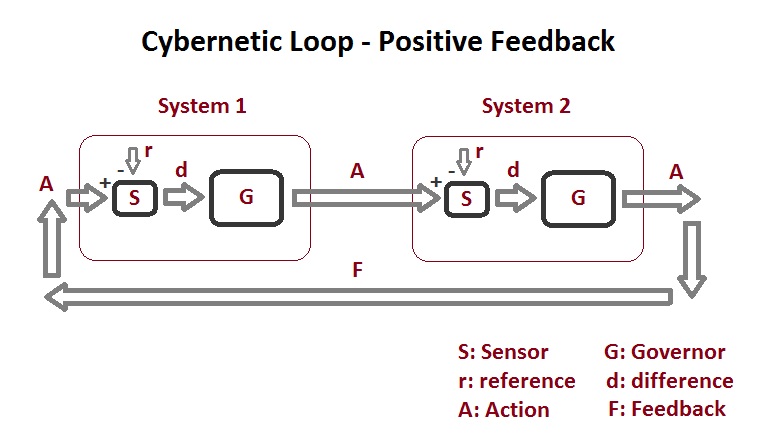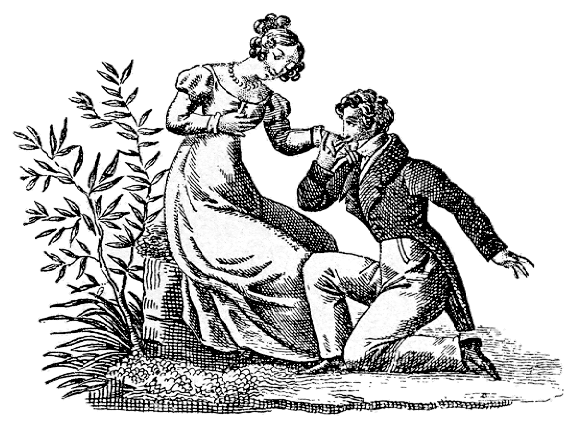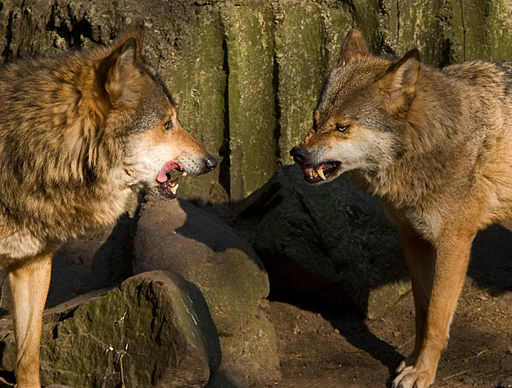
M: Which do you think comes first, chicken or egg?
P: Isn't that an unanswerable question? If you say egg, then where does egg come from? Chicken. If you say chicken, then where does chicken come from? Egg. It goes round and round. So there is no answer.
M: That sounds logical. But the biological world has very little to do with logic. It’s more about changes. Anyway, the answer is egg.
P: Yeah? Why?
M: Well, because in its lineage chickens are evolved from something that was not called chicken. Somewhere along the propagation line some of the mutable non-chickens laid eggs that came out as chickens. So the egg came first. Or it could be that some of those non-chickens got caught and became domesticated by early humans. Their offspring adapted to the farm life and became chickens. That transition was still from non-chicken to egg to chicken. The egg came first.
P: That’s a trick shot. Okay, so what is the scoop of positive feedbacks and species diversification?

Book of Genesis Chapter 1-11 by Distant Shores Media/Sweet Publishing.
M: Diversification of living species is largely due to progressive changes. And positive feedback is a mechanism of such progression. It is based on interactions of two parties where feedbacks are amplified. Another theory is that divergence in nature is caused by a single agent. That single cause can be mutation, as proposed by Darwin. Or it can be the christian God. According to the Bible, God separated heaven from earth, day from night, land from ocean, animals from plants, birds from fishes, woman from man. By that account, God’s separations diversified the world.

Diversification by positive feedbacks is a totally different story. It happens with two parties mutually molding and changing each other. ‘It takes two to tango,’ so to speak. As for the single-cause explanation, the saying goes ‘what is the sound of one hand clapping?’ That is to say, single-cause is a mystery. Like 'gravity' or 'desire', it is a name without a background.
Anyway, a simple positive feedback loop consists of two active systems with individual characteristics. By reacting to feedbacks, the two systems change gradually at first, then more and more until they take on new characteristics that are stable against the feedbacks. For example, two active systems are a man and a woman. They have eyes (and ears, nose, etc) as sensors and brain as governor. How do they change from being singles to being married? Or from being married to being divorced? It goes like this. Each person’s brain receives and amplifies information of sensory differences and turns that into actions. One person’s action is the other person’s feedback. By the circulation of feedbacks the two people (systems) diverge toward new states of affair, namely getting married or divorced. This mutual-molding process is self-initiated and self-actualized.
P: Wait, I can see that divorce is separation, which is a way to diversity. But why do you consider marriage also a process of diversification or separation?

1815-regency-proposal-woodcut.
M: Yes, marriage is definitely not separation for the bride and the groom. However, there is another side to it. A married person is a separate entity from a single person. Legally so anyway. That is diversity. His or her personal relationships to others are changed drastically by marriage. He/she goes from a self-centered person to a nurturing, providing spouse for his/her mate. The changes in relationships and mental outlooks are what separate them from their old selves. The husband becomes dominant while wife submissive, forming a complementary relationship of a traditional marriage. A married couple is not the same as the sum of two persons. They are categorically different like the mathematical sets vs. elements.
P: I think I know what you mean. It is like the different logical types described in Principia Mathematica by Alfred Whitehead and Bertrand Russell. Different logical types have fundamentally different properties. But I don’t suppose people are logical types, do you?
M: Well, they are and they aren’t. There are reasons supporting the argument either way, depending on the premise and perspective. But you do agree that singles pay taxes in a different bracket than married couples, right? Anyway, here is how positive feedbacks form marriages. Suppose it is a marriage of love (there are other types of marriage) between a man and a woman. It starts with the two persons noticing each other. The man sees the woman and compares her to 'common women' (his point of reference) and notices a difference. That difference is attractive. So he approaches the woman. When she sees the approaching man, she also notices a difference by comparing him to the 'average guy' in her mind. To make the case simple, let’s say to her it is also an attractive difference. So she responds to his advance by inviting him to do more. From then on each action she and he takes makes the attractive differences stronger and stronger. Very rapidly they get closer and closer, until they can’t tolerate any separation at all. The result is that they come to live together, with or without a marriage. In engineering terms, their actions have reached the level of saturation that cannot be advanced further under the circumstances.
In positive feedbacks, a difference detected by a sensor can be attractive, repulsive, or neutral. It is a quality rather than a quantity. Neutral difference is perceiving an ‘average person’ that stirs no particular feeling or action. It’s like feeling that they all look alike and there is nothing special.
In negative feedbacks the differences are more quantitative than qualitative. It is a positive or negative numerical value. Take Watt’s steam engine for example. A positive difference is when the speed of the turning flywheel is faster than the threshold setting, and negative difference is when the speed is slower than the threshold. Negative feedback is reduction feedback. The centrifugal governor reduces a positive difference by closing down the fuel intake to lower the steam level, thereby slowing down the engine speed. To reduce a negative difference, the centrifugal governor opens up the fuel intake to increase the steam level, thereby increasing the engine speed. The positive and negative differences become smaller and smaller by the governor's reduction, and the engine speed stabilizes around the threshold setting. That’s the negative feedback mechanism.
Positive feedback is amplification feedback. The governors (the brains of the two parties) amplify the attractive differences in the case of marriage. Marriage is a symbiotic relationship where two parties are united together by mutual benefits. Each one gives the other something, and gets something else in return. There are many symbiotic relationships in the biological world. Ants and aphids are one. Humans and agricultural plants/animals are another. Within the human society such relationships also exist. It happens between banks and businesses, industry and military, government and people, etc. We can say that positive feedback loops are in all such relationships.
The great anthropologist Gregory Bateson created the term complementary schismogenesis (schis-: division, genesis: creation) to describe how relationships are formed between sports teams and fans, and lords and vassals. This term matches directly to the positive feedback mechanism of attractive differences. Like other symbiotic relationships, the athletes like the fans’ cheers while the fans love the athletes’ performance. Lords like vassals' obedience, and vassals like the stability and leadership provided by the lords. They all act to get more of what they love. Consequently their interactions evolve into complementary relationships that look like pairs of exhibitionism-spectatorship or dominance-submission.
This can happen across species. There is a book called The Botany of Desire by Michael Pollan. In it he describes the history between humans and four plants - apples, tulips, marijuana, and potatoes. These plants symbolize men’s desires for sweetness, beauty, pleasure, and sustenance. Professor Pollan makes the case that humans like apples for their sweetness while apples like humans for their contribution to species propagation. In that sense the agricultural relationship is also a two-way symbiotic relationship. Therefore the development of agriculture can also be modeled by positive feedbacks of attractive differences.

Paul Gauguin - Apples, Pear, and Mug. ISBN 3936122202
Distributed by DIRECTMEDIA Publishing GmbH.
P: Okay, I see what kind of rabbits you have pulled out of your hat. Marriage between two people comes from positive feedbacks of attractions. That also applies to symbiotic unions between ants and aphids, farmers and plants, and government and citizens. The participants are different from their previous selves because the union changes their relationships and identities. But how do you account for divergence in dogs like bulldog and beagle? How do you explain the physical differences since that is usually what we mean by diversity?
Adaptations
M: The divergence of physical traits between bulldogs and beagles is due to selective breeding, enforced by man first. If you leave them alone they can crossbreed and become mutts that will look alike again eventually. Also, animals and plants always adapt to their environment when it comes to survival. They may move to a new environment, or the environment may be changed by natural catastrophes. Either way, a new environment requires its inhabitants new physical adaptations. Adaptations generate new bodily traits. That is a major factor of how diversity of species' physiques takes place. Moreover, the changes in inhabitants will in turn affect the environment, making it to change as well. That is the theory of co-evolution where the river molds the bank and the bank guides the river. Which is a complementary schismogenesis of a higher order.
There is still another type of natural divergence. Bateson called it symmetrical schismogenesis. And divorce is an example of that. I call it division by repulsion since it matches a positive feedback mechanism where repulsive differences are amplified.
P: Okay, you have explained natural diversity of physical traits. I guess that is why Asians do not look like Europeans because they do not interbreed. If they do, then the biracial children will themselves look alike. But you also say that divorce is an example of natural divergence. Does that means husband and wife will naturally separate? What are the repulsive differences that you mentioned?

Repulsive differences.
M: Couples living together have plenty of frictions that can lead to confrontations or even divorce. Marriage is said to be one of the most difficult relationships to maintain. They sometimes sleep separately after having a big argument between them. But to reach the level of divorce, the repulsion they feel must overwhelm all other factors that bond them together. Here is an example of symmetrical schismogenesis that builds up repulsive differences.
A husband and wife face an issue after their honeymoon. Say it is about whether to send their child to a private school or not. The woman is pro and the man con. The reason she gives him in support of yes is deemed unimportant by him, after he compares this reason to his point of reference. He then explains his reason for no to her, which she takes as an excuse from her point of reference. So she adds more reasons and points out his errors in judgement. He does likewise by amplifying the faults in her rationale. Soon each party is entrenched in their separate positions. Further discussion between the two becomes an escalation from argument to anger to fight. That is the positive feedbacks (amplification) of repulsive differences. Usually couples are amenable to reconciliation so they stay married. Some couples let arguments get out of hand and do not compromise. Those are the ones that divorce each other.
Symmetrical invalidation of the other party’s viewpoint is not limited to divorce. You can also see it on televised political debates. The Congress of the U.S. is presently an assembly of divorced political parties under one roof. Same thing happens in the other countries of the world, democratic or not. This is because repulsive differences exist naturally in a cybernetic circuit of people where 'self' is emphasized. If it does not turn into political parties under democracy, then it is factions under dictatorship, or cliques in school, or sects in religions, or companies in business, or groups in academia. Once a fissure starts, further divisions follow. So there are supply-side and demand-side economic philosophies, free-market and regulation policies, Christianity and Islam beliefs, Catholics and Protestants and Shiites and Sunnis practices, geeks and jocks activities. Interestingly, according to Bible, that's actually the design God had for men in the story of the Tower of Babel.

Tower of Babel.
P: The Tower of Babel? That reminds me of the story of Adam and Eve. After they ate the fruit from the forbidden tree in the Garden of Eden, their eyes were opened, and they saw good from evil, nakedness from covered body. It is just like schismogenesis. They perceived differences in things and started to react to the differences. That made them hide from God.
M: To me this is almost like a sperm enters an egg. The fertilized egg begins to divide into two. Then the two cells split again and again. The division of cells is like symmetrical schismogenesis, where the forces of positive feedback of repulsive differences push the cells apart. At the same time, some of the cells form organs and conduits that connect the organs. That is like complementary schismogenesis, where the forces of positive feedback of attractive differences draw the cells together till they become a distinct unit.
P: That is interesting you combine symmetrical and complementary schismogeneses to sketch the development of embryos. Can they really be combined that way?
M: Sure, why not? There are more combinations than just symmetrical and complementary schismogeneses. Here is another path to diversity: specific combinations (permutations) of positive feedbacks. By the way, when a divorce happens, the two separated parties may move to different environments. This is followed by adaptations. If they are wolves instead of people, the adaptation to new environments may turn them into brown wolf or grey wolf. Maybe with enough generations of separation the adaptations mold them into coyotes or timberwolf. How is that compared to my good ol' non-chickens evolved into chickens?
P: Hmm, that is a pretty bold assumption, but pretty slick too.